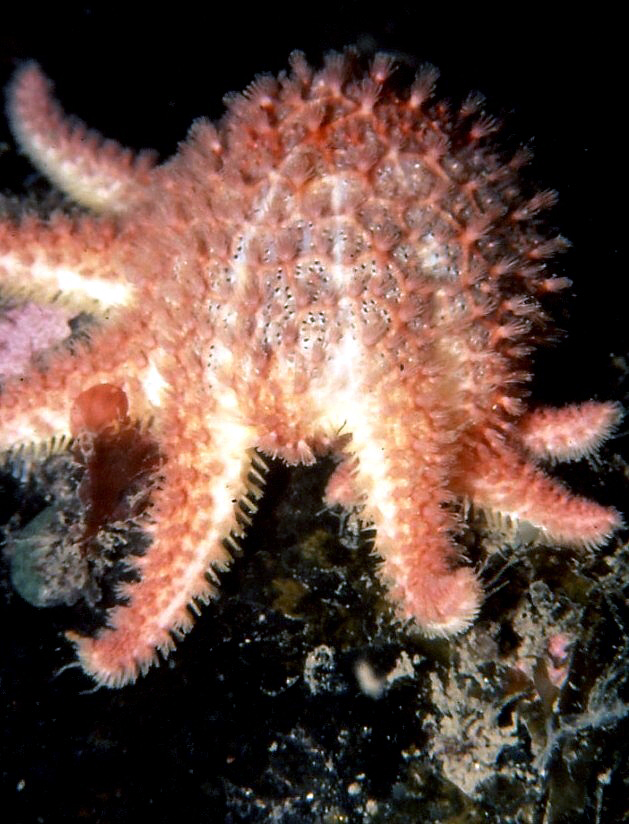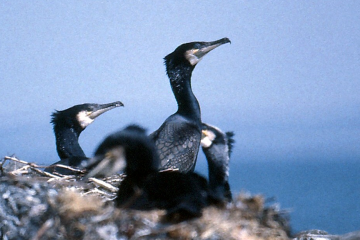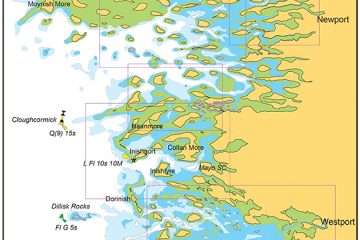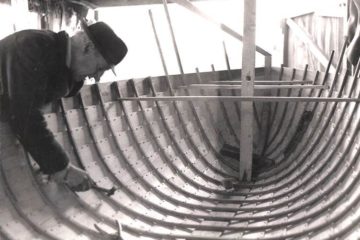by Bob Brown
If there’s one animal that symbolises marine life, it must surely be the starfish. Illustrations of the seaside invariably have a starfish in the scene and children are fascinated by them. Just as often however, when we really encounter these beasts, they are dead, washed up, and usually dried to a pale shadow of their real selves, and usually smelling somewhat. Or worse, flogged off as souvenirs.
Let’s put the record straight! Whilst we floating folk may not instantly encounter starfish on a cruise, there’s a fair chance we’ll find them on our mooring strops, under pontoon structures, and on harbour walls. You can be sure that our very youthful cruisers will find them on rock pool expeditions. They are all over the place, or more appropriately, all under the place, and they are often very colourful.

Spiny starfish Marthasterias glacialis on a pontoon structure and obligingly showing us its tube feet in
Kilmelford, Argyll & Bute, Scotland.
Photo by Linda Brown
Starfish are the descendants of a long and very ancient line of animals that include sea urchins, sea cucumbers, feather stars, and brittle stars. Formally, they are called ‘echinoderms’, ie ‘spiny skins’, sea urchins being the spiniest of the lot. If you are interested in antiquity, take a wander along some shores in Co Sligo. You’ll find stones and boulders covered in multitudes of spots, millions of them. These are the fossilised stalks of Crinoids, sea lilies, but not a plant at all, a part of the Echinoderm tribe, and they date back to about 350 million years ago. Sometimes you’ll actually find their tentacles cast in stone.
But let’s concentrate on the starfish. Most have five arms, but the dramatic looking common sun star, may have anything from ten to thirteen arms. For beasts that are supposedly primitive (they aren’t really) these are complex organs. If one is broken, or bitten off, it is capable of growing a new central body if it hasn’t been damaged too badly. And the previous body is well able to grow a new arm as well, although it may not be quite the size of the original. Turn the starfish over, and you’ll find intricate rows of tiny transparent sucker-like feet – tube feet. These, by moving in rhythmic pulses along the arm, allow the starfish to creep across the seabed, though of course there’s a cunning co-ordination mechanism that keeps the teams of tube feet under the other arms contributing to the directions rather than trying to pull the wrong way.
However, that’s only the beginning of the story, because the arms and tube feet have another role. Starfish are major predators of the seabed, feeding on carcasses, organic detritus, other slow moving fauna, particularly molluscs, and even other starfish. It’s not a pretty operation. If a starfish encounters a mussel or clam for example, it wraps its arms around the victim, latches on the tube feet with their suckers, and slowly pulls the two shell halves apart. When finally, the exhausted shellfish gives way, the starfish everts its stomach, inserts it into the gape of the victim’s shell, and then digests the animal alive, finally withdrawing its stomach when the job is done.

A common sunstar Solaster papposus digesting its victim in Strangford Lough. Photo by Dave Erwin
There is hardly a single marine habitat where the seabed doesn’t have one or more species of starfish, although they are absent from the middle to upper shorelines, not being very good at resisting desiccation when the tide is low.
We encounter the most frequent species, the common starfish, yellowish or orange, on reefs, wrecks, mussel beds (of course), and often accompanied by the spiny starfish, with a skin dimpled by spiny protrusions. In the depths, and sometimes along the low water line, we can find a small deep red-purple starfish, with smooth arms, going by the glorious name of bloody Henry. Sandy or stony sea beds have the more primitive and appropriately named seven armed starfish. They are enthusiastic breeders, each adult capable of producing over two hundred million eggs a year – thank goodness for high mortality in the larval stages! Along the lower levels of the shoreline, under boulder and weed, you may find the cute little cushion star, a sort of dirty green usually, and looking, well, a bit like a tiny cushion, with short dumpy arms.
In more northern parts of Ireland, and Scotland through to sub-arctic areas, we find the northern starfish. Like many northern species, it doesn’t merely spawn eggs and sperms into the sea giving rise to planktonic (drifting) larvae. Instead, the female gives birth to live young in the spring, and with its arms wrapped around the tiny offspring, gives up feeding and cares for them until their first tube feet have developed and they can forage for themselves. This species is currently retreating northwards due to climate change and increasing sea temperatures.
Shifting species distribution with climate change is as much a feature of marine life as it is in the more documented species and habitats on land. The European Environment Agency is reporting that sea temperatures in European waters have been rising by about 0.3°C per decade in recent years, and expected to be up to 6°C warmer by the end of the century. Aside from greater warmth, this may affect the way some of the ocean currents operate around Ireland’s coasts.
We should not underestimate the sensitivity of marine life to these changes. Ireland’s marine life lives at a crossroads where subarctic species just manage to coexist with subtropical species at the northern end of their ranges. The situation is made more complex by a series of oceanic fronts around our island. St George’s Channel receives relatively warm water entering the Irish Sea, whilst to the north of Malin Head, extending to Islay, a front separates warmer western waters from cooler to the east. Again, between Co Down and the Isle of Man, a seasonal gyre develops where warmer surface waters are separated from those in cooler depths.
These systems support different species according to their temperature contrasts, and thus profoundly influence their distributions. What the scene will be like by the end of the century, we can only speculate, but it will almost certainly be different. By then our descendants may well be intrigued some very different species of starfish creeping up their moorings!


